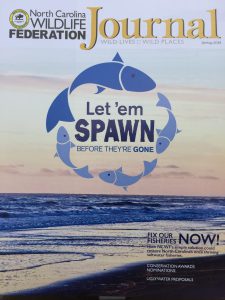20 Jul Senate will sit on “Let ’em Spawn” bill
We still agree that HB 483 is “a common-sense starting point for a management policy” despite much concern by some in the recreational community on the ramifications the new rules could have on the bait fishery. While HB 483 is not a panacea for all of the ills facing our declining fisheries, it is a good first step.
Despite criticism that length at maturity is not appropriate to apply to all fisheries, it is unequivocally the right approach for the six species named in this bill and the other species managed by North Carolina. The NCDMF website answers the question “Why do we have fisheries rules?” In discussing various types of fisheries rules they indicate that size limits “are meant to protect fish of spawning size before they are caught”. Who can disagree with this principle?
The use of mullet as bait will continue to be addressed by the MFC and DMF during the Fisheries Management Plan process. For example, since the 2015 Striped Mullet FMP was adopted, landings of striped mullet have declined, even in the absence of a minimum size or harvest limit. HB 483 requires some immediate action by fisheries managers to reduce the harvest of spawning fish. A commercial size limit would be one corrective action that would come from HB 483, and options exist in the bill that would allow the MFC and DMF, through the normal FMP process, to address the continued use of striped mullet as bait through separate recreational size and harvest limits.
We have also been told that Senate Bill 554, Marine Fisheries Reform, will not be heard by the House this session. CCA NC has tried unsuccessfully to provide input to DEQ on our many concerns with SB 554. CCA NC has offered revisions to the Fisheries Reform Act of 1997 since 2015 that would change the state’s current management standard from “maximum exploitation” to one of “responsible exploitation” given the public trust nature of coastal fisheries resources. DEQ has made it clear they have no interest in any compromise on SB 554.
The focus for both Legislative bodies is now on working out a budget compromise with Governor Cooper, if at all possible. All indications are that this could be a long process but all other committees are winding down and we do not expect much legislative action beyond the budget negotiations in the next few weeks.




